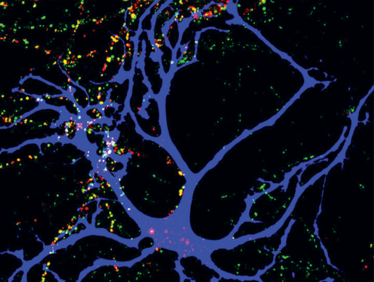Missed Connections
A protein critical for synaptic plasticity in baby mice could hold clues to the origins of autism

The sheer number of changes that take place during early development can make it hard to pinpoint the cause of disorders such as autism. But a recent study sheds light on how the brain is wired to process sensory information during infancy and how disruption to that process could cause ongoing problems (1).
Cagla Eroglu, Assistant Professor of Cell Biology and Neurobiology at Duke University, and her team previously identified hevin as an astrocyte-secreted protein. Their next task was to find out what role the protein plays. “We knew that hevin is localized to synapses, and also that in mice without hevin, synaptic junctions have defects both on the presynaptic (axonal) and postsynaptic (dendritic) compartments. These observations led us to hypothesize that hevin is capable of interacting with both sides of the synapse, and bridging the synaptic gap,” says Eroglu.
The researchers found that hevin did indeed interact with proteins on both sides of the synapse – specifically neurexin-1α (NRX1α) and neuroligin-1B (NL1). Their research also established how critical those interactions are in sensory development. Mice lacking hevin, NRX1α, or NL1 all have identical defects in synapses between thalamus and cortical neurons. During a critical window in development, activation of this class of synapses by sensory experiences helps shape cortical circuits.
“We found that mice lacking hevin did not have the ability to remodel/reshape their cortical connections when their visual experience was altered. Remarkably, when we supplied hevin back to the cortical astrocytes, we could rescue plasticity. As we identified hevin receptors and their associated proteins, we started to realize all these proteins are encoded by genes that are linked to autism and other neurological disorders. This indicates that plasticity in the thalamocortical circuits may be critically impaired in autism,” says Eroglu.
- SK Singh et al., “Astrocytes assemble thalamocortical synapses by bridging NRX1α and NL1 via hevin”, Cell, 164, 183-196 (2016). PMID: 26771491
My fascination with science, gaming, and writing led to my studying biology at university, while simultaneously working as an online games journalist. After university, I travelled across Europe, working on a novel and developing a game, before finding my way to Texere. As Associate Editor, I’m evolving my loves of science and writing, while continuing to pursue my passion for gaming and creative writing in a personal capacity.















